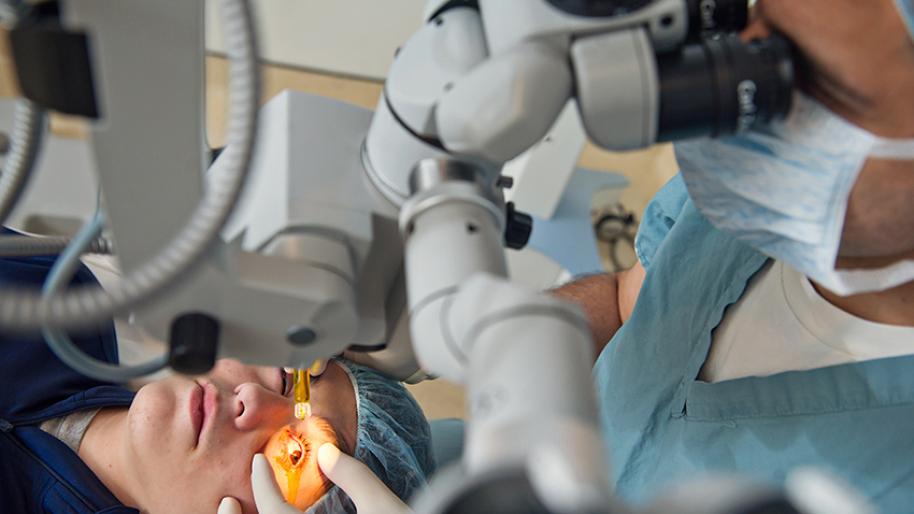Home » Corneal Cross-Linking FAQs
Corneal Cross-Linking FAQs
We see many patients in the office who need corneal collagen cross linking procedure from two reasons: progressive keratoconus and corneal ectasia following refractive surgery.
Here are some other frequent questions asked by patients about CXL procedure:

What is Corneal Cross Linking?
Corneal Collagen cross linking is an FDA approved procedure that strengthens the collagen fibers in the corneal tissue in order to decrease the progression of keratoconus or corneal ectasia. Prior to the CXL procedure, patients are instructed to use antibiotic eye drops in the treated eye. During the procedure, topical anesthesia in the form of eye drops is given 30 minutes prior to the cross linking procedure. Next, the surface epithelial layer is removed or roughened up. The eye is bathed with liquid riboflavin (vitamin B2) for 30 minutes and then exposed to a controlled amount of a specific wavelength of ultraviolet light for 10 to 30 minutes.. A bandage contact lens is placed onto the surface of the eye at the end of the procedure and kept on for several days to expedite healing of the surface layer of the cornea and for comfort. The combination of the riboflavin and ultraviolet light results in strengthening of the bonds between the middle layers of the cornea. This usually stabilizes the cornea and prevents or at least reduces further changes in the shape of the cornea. This procedure is often done on both eyes at the same time. The recovery time is about three to five days. Visual recovery takes about four weeks. Other benefits may include an improvement in uncorrected visual acuity and a decrease in astigmatism. This may result in a change of prescription for contact lenses/glasses.
Why do we perform the Cross Linking Procedure?
When the cornea becomes weakened by progressive keratoconus or corneal ectasia following refractive surgeries, an exciting new option to strengthen the cornea, collagen cross-linking (CXL), is now available to strengthen the cornea. This procedure strengthens the corneal tissue using UV light and prevents further progression of the keratoconus or corneal ectasia. It has been performed in Europe and South America for over a decade and was finally FDA approved in the United States in April 2016 and has completely revolutionized the treatment paradigm for keratoconus. It drastically decreases the chance of needing a corneal transplant for keratoconus later on in life. Corneal transplantation was previously the final treatment plan for progressive keratoconus or corneal ectasia following refractive surgeries and now the cross linking procedure has decreased the need for this invasive procedure for patients with keratoconus.
Does Corneal Cross Linking improve vision?
While there are many benefits of the cross linking procedure, vision correction in and of itself is not an intended goal. Data shows that uncorrected visual acuity as well as astigmatism does actually improve after corneal crosslinking, but usually that uncorrected visual acuity poor enough to warrant contact lenses and glasses anyway. So the prescription of the contact lenses and glasses may change weeks after the procedure for a lower amount, but vision correction is not the intended goal of collagen cross linking. Patients with keratoconus are recommended not to rub your eyes at any point, because this can increase blurred vision and cause keratoconus progression and decrease in visual acuity.
How long does cross linking take to heal?
Depending on whether you have epi on or epi off cross linking, the healing time varies. In both epi on and epi off cross linking, the front layer of the cornea in the treated eye is disturbed or completely removed (in the case of epi off cross linking), allowing the penetration of the riboflavin drop. Before the CXL procedure, you will be given some antibiotic drops to use in the treated eye for several days. Contact lenses should not be worn prior to the cross linking procedure or the day of the CXL procedure in either eye. 30 minutes prior the procedure, topical anesthesia drops will be placed in the treated eye, prior to the procedure on the surface of the cornea. After the CXL procedure in both epi on and epi off cross linking, a bandage contact lens is placed on the surface of the eye, sometimes along with a special amniotic membrane. This bandage contact lens is removed in the office at about 5-7 days after the procedure from the treated eye. The goal of the bandage contact lens is to promote healing of the epithelium, the surface of the cornea, and to reduce pain and decrease sensitivity to light. During the 5-7 days after the cross linking procedure, if there is some discomfort, artificial tears can be used continuously to reduce pain and sensitivity to light. It is recommended not to rub your eyes, as this will not reduce pain or decrease sensitivity to light. You should expect to have blurred vision worse than baseline in the treated eye, as well as feeling light sensitive. The blurred vision and light sensitivity will decrease gradually over the weeks after the procedure.
Is corneal cross linking covered by insurance?
Epi-off cross linking, the FDA approved version, is on occasion covered by insurance. This all depends on the exact insurance plan and exact coverage. Epi-on cross linking is not covered by insurance.
Does corneal cross linking hurt?
The procedure itself does not hurt, but it is sometimes unpleasant to lay flat for over 30 minutes for each eye for the cross linking procedure to be performed. An oral anti-anxiety medication such as Ativan is given 30 minutes prior the CXL procedure, along with anesthetic eye drops.





